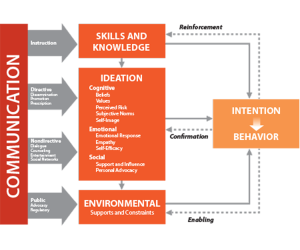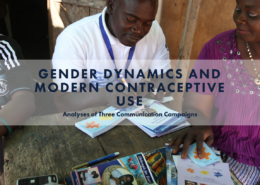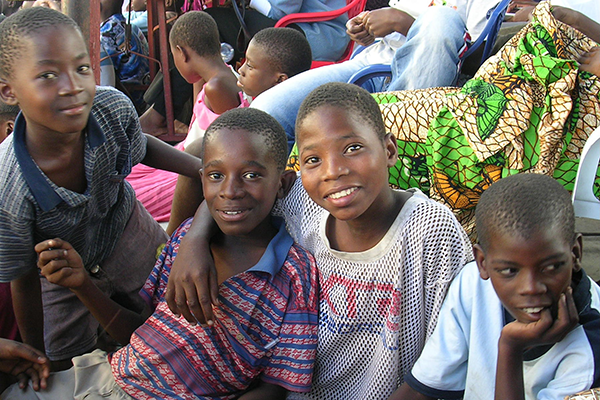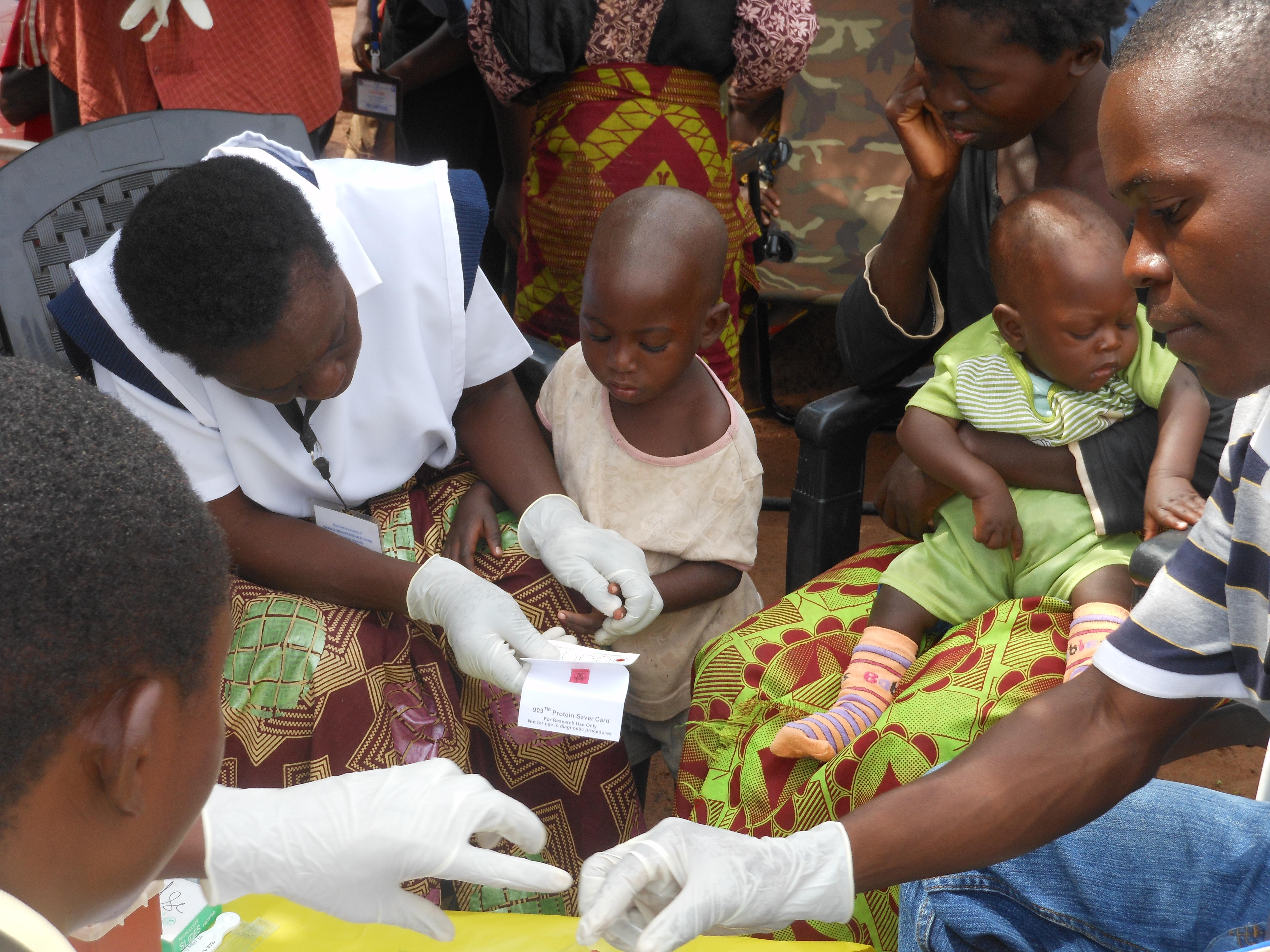
The Ideation model emphasizes how communication affects the intermediate outcomes that in turn determine behavior change.
High-quality research is crucial for supporting advancements in social and behavior change communication (SBCC) programs. HC3 worked with ministries of health, international partners, and national and community organizations in over 30 countries to provide evidence-based programs, strategic support and rigorous research.
We incorporated theory into practice, used qualitative and quantitative methods to inform program development, evaluated programs and assessed project impact. We also used innovative methodologies to advance SBCC research and to meet the needs of programs across HC3’s technical areas: family planning; HIV and AIDS; reproductive, maternal, newborn and child health; malaria; and SBCC in emergencies, such and Ebola and Zika.
Public Health Impact
HC3’s family planning (FP) research includes a comprehensive mix of formative research, intervention evaluations and theory analyses. Baseline assessments in Nepal, Nigeria and Angola have helped to fill evidence needs for FP and reproductive health (RH) programs. In a literature review of behaviors related to healthy timing and spacing of pregnancies (HTSP), HC3 identified forgotten audiences: women of advanced maternal age and women with high parity pregnancies. Soon after, HC3 conducted secondary analyses and qualitative research for these audiences using data from Togo and Niger, to inform the development of HC3’s HTSP Implementation Kit. HC3 also conducted a multi-country literature review and secondary data analysis of urban youth RH behaviors (see Youth).
HC3’s FP evaluation studies explore the impact of communication channels in Tanzania, gateway behavior promotion in Nigeria and pretest results of HC3’s new Smart Client and Smart Couple tools. HC3 also conducted analyses to shed light on the relationship between communication interventions and gender equity as well as reproductive empowerment. To solidify the case for strategic health communication, HC3 assembled a package of evidence with factsheets, summaries and infographics.
HC3 synthesized current evidence and tested new approaches in HIV programming through the publication of two Journal of Acquired Immune Deficiency Syndromes (JAIDS) supplements and several studies. In 2014, HC3 sponsored a special JAIDS supplement devoted to health communication and its impact on HIV prevention and care. It was the first collection of Open Access articles providing evidence of health communication’s impact on HIV prevention and included thirteen articles. In 2017, another JAIDS supplement was published consisting of ten articles that make the case for using health communication in highly diverse HIV contexts along the HIV continuum of care.
Additional HC3 studies have looked closely at a critical HIV prevention tool: voluntary medical male circumcision (VMMC). This includes a literature review identifying VMMC implications for male adolescents in Sub-Saharan Africa, a study on the quality of counseling within adolescent VMMC services and a commentary for scaling up and sustaining VMMC HIV prevention benefits. HIV program evaluations include stigma reduction strategies in Mozambique, early childhood development in Swaziland, social marketing of condom use in Zimbabwe and male engagement strategies for improving treatment initiation and ongoing retention in care Côte d’Ivoire. HC3 also created a compelling package of evidence for health communication on HIV prevention outcomes and synthesized evidence of the impact of community-level factors.
In 2013, HC3 collaborated with USAID and UNICEF to convene the Evidence Summit on Enhancing Child Survival and Development in Lower- and Middle-Income Countries by Achieving Population-Level Behavior Change. For the Summit, evidence review teams examined published peer-reviewed and gray literature across a wide range of social and behavior change dimensions impacting child survival and development. HC3’s research contributed to the evidence review of community engagement and the role of health systems and policy for child survival.
HC3 conducted another evidence review on demand for the 13 underutilized life-saving commodities identified by the UN Commission on Life-Saving Commodities for Women’s and Children’s Health. The report synthesizes effective practices in implementing demand generation programs and includes a series of spotlights for each commodity. HC3’s research also examined the effect of antenatal care counseling and spouse communication on RMNCH-related behaviors and evaluates community engagement approaches used to re-generate demand in countries impacted by the 2014 Ebola outbreak.
The impact of SBCC for malaria outcomes has not yet been fully captured in literature. HC3 worked with local ministries and implementing partners to explore existing data sets and analyzed factors influencing net use in Liberia and the impact of SBCC on net use in Nigeria. HC3’s malaria research investigated multi-level correlates of other malaria prevention behaviors including care-seeking for children with fever, malaria prophylaxis during pregnancy and artemisinin-based combination therapy (ACT) treatment across Liberia, Nigeria, Madagascar and Mali.
As the Secretariat of the Roll Back Malaria (RBM) Community of Practice working group, HC3 helped create an indicator reference guide for designing and monitoring malaria SBCC interventions. HC3 also conducted desk reviews on malaria case management and malaria in pregnancy and reviewed over 400 articles to create a package of evidence including an online database, fact sheets and infographics.
During the West Africa Ebola outbreak (2014), HC3’s research activities gathered important insights about Ebola knowledge, attitudes and practices to better inform intervention design. HC3 also contributed to research activities evaluating the Ebola response, the risk communication response, the use of SMS-based Ebola surveys and stigma SBCC activities in affected countries.
As the crisis waned, research shifted focus to assess post-Ebola attitudes and trust in the health system. These studies were used to inform post-Ebola campaigns that re-generated demand for reproductive, maternal, newborn and child health services. Assessments were also conducted for Ebola communication preparedness in Côte d’Ivoire and knowledge management needs of government health workers in Sierra Leone. To examine the successes and challenges of SBCC work during the Ebola epidemic in a single issue, HC3 also developed a special issue of the International Journal of Health Communication, focused on Ebola.
Two months after WHO declared Zika a public health emergency of international concern, HC3 mobilized a team of experts to conduct an SBCC landscape exercise in four Central American countries: Honduras, El Salvador, Dominican Republic and Guatemala. The HC3 Zika team examined SMS survey data to assess Zika knowledge and prevention behavior and social media feedback related to each country’s Zika communication campaigns. Qualitative research on Zika prevention methods was also conducted. These analyses were used to shape the Zika communication strategies at the national level for these four priority countries.
In Guatemala, HC3 worked with partners from 18 USAID-funded projects to develop an overall brand identity and SBCC strategy for the Western Highlands Integrated Program (WHIP) which integrates health, family planning, income generation, nutrition, education, local governance, water and agriculture. To inform the comprehensive strategy, HC3 designed three landscaping studies to better understand how the powerful forces of religion, mobile phone ownership and use, social media and internet use and radio programming can be better utilized to promote healthy behaviors in the Western Highlands of Guatemala. HC3 also accompanied their review of USAID’s programmatic portfolio with a literature review and research on priority health and social issues in the Western Highlands.









